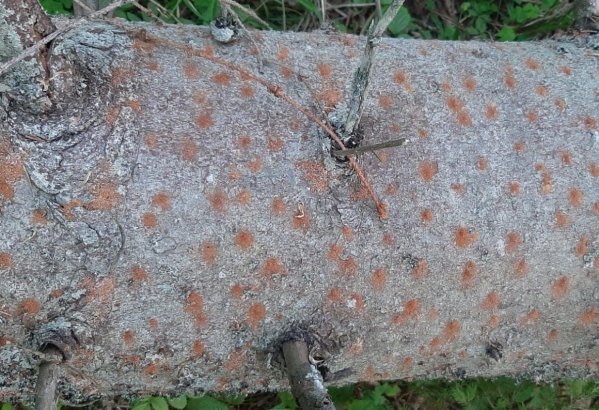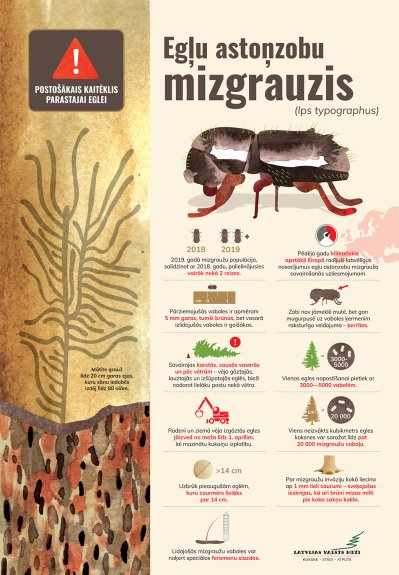An Educational Film about European Spruce Bark Beetles has been Made for the Needs of Forest Owners
The European spruce bark beetle is the most devastating pest for spruce stands in Latvia, and it is able to destroy even healthy stands. Therefore, JSC “Latvia's State Forests” (LVM) and the Latvian State Forest Research Institute “Silava” have created an educational film for forest owners, in which experienced experts share tips on how to recognize infested trees, when and how to act to reduce spruce pest, limit further spread and how to minimize risks in silviculture.
Agnis Šmits, Leading Researcher at the Latvian State Forest Research Institute “Silava”, tells that the spruce bark beetle is an approximately 5-millimetre-long beetle with eight teeth. The bark beetle can cause more damage to spruce stands than all other forest pests taken together, therefore it must be taken very seriously. Two generations of this insect develop in Latvia – beetles fly when the average air temperature is above 20 degrees. When they fly out of the ground, they gather in wilting or weakened spruces. If there are many beetles, they can destroy even completely healthy spruces.
“Spruces resist attacks of bark beetle males by releasing resin. However, bark beetles are quite strong and can overcome this tree resistance. Once bark beetles have settled down in a tree, female beetles begin to gnaw tunnels and lay eggs. One female can lay up to 60 eggs. Once eggs have been laid, the beetles fly a second time until mid-July – this is called the 'sister generation'. At the beginning of July, a part of the young beetles goes to sleep, the other part – form the second generation until autumn sets in. Larvae that have not managed to develop, die in winter; on the condition that the winter is cold, of course,” Agnis Smits tells about the development of bark beetles.
Infestation of young bark beetles is difficult to spot
When a spruce is attacked by a beetle, it is difficult to notice at first, because the tree is still green and the holes in the bark are very sparse and small. Therefore, forest owners should pay attention to the bark flour that accumulates in twigs and on the root collar.
“In a dry summer it takes up to 3 thousand beetles to kill one average-sized spruce; if a summer is wet – it takes up to 7 thousand beetles, because trees are stronger. If there are not enough bark beetles, they spread and multiply in tree stumps, windswept and broken trees,” tells the expert of the Latvian State Forest Research Institute “Silava”.
Measures to control spruce bark beetles must be taken in good time
In areas where spruce stands have been damaged by winds in the previous autumn and winter period, it is necessary to develop these areas before the beginning of the spruce bark beetle flying season, because the pest first develops in weakened spruces.
Great attention should be paid to spruce stands that are older than 50 years. Once spruce bark beetles settle down in a tree stand, it can no longer be saved. By cutting it down in time, you can save the adjacent yet intact stands.
“Measures to control spruce bark beetles mainly concern the felling of damaged trees and timely removal of prepared timber assortments from the forest during the summer months. Depending on the number of damaged trees, a sanitary selective felling should be carried out upon receipt of the sanitary opinion of the State Forest Service. When cutting trees in a continuous area, the additionally prepared assortments can be used as a trap, ensuring that flying bark beetles use these assortments for their development; it is also possible to place pheromone traps for catching flying beetles,” tells Edijs Leišavnieks, LVM Forest Protection and Fire Fighting Manager.
Sparce forest in youth, good stock in old age
“The spruce stands planted during the Soviet era can now be considered as overgrown. They were planted for the needs of Sloka paper factory, they currently do not have a crown, so they have a weak root system and stands are not resistant to wind damage. My experience as a forester for more than 40 years shows that spruce bark beetles damage as many cubic metres of wood as the wind falls down in bad conditions,” tells the experienced forester Kaspars Riže.
The forester points out that when restoring forest, it is important to choose high-quality seedlings, the young seedlings should not be planted too tightly, and when the spruces have grown bigger and started competing with each other, the main species should be thinned to a distance of 2 to 2.5 metres. Then it is important to allow the stand to grow until tending is carried out, and then perform the renewal felling. The expert also points out that forest owners should be allowed to decide for themselves on the intensity and types of management.




